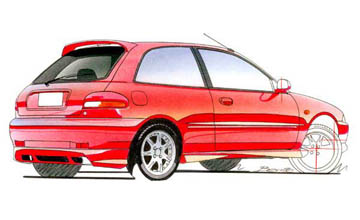BY GAUTAM SHARMA | 14th Jun 2001

Proton made its Australian debut in late 1994 but has not made a significant impact on the local market, averaging less than 3000 annual sales until the end of 1999.
The company revised its model line-up and sharpened its pricing strategy in September, 1999, with a view to increasing its market share.
The new price structure meant nearly $3000 was slashed from the cost of the Satria XLi. It now began to represent genuinely good value for money, costing less than nearly all its rivals when similarly equipped.
Proton has upped the ante with the limited-edition XLi "Son of a Gun", which supplements the equipment list with a full body kit, CD player, sports steering wheel and gearknob and chrome exhaust extension.
The standard XLi already comes equipped with air-conditioning, remote central locking, power windows, alloy wheels, a four- speaker radio/cassette, engine immobiliser and split/fold rear seat.
The smartly styled Satria is based on previous generation Mitsubishi Mirage underpinnings but benefits from enhancements carried out by Proton and British sports car-maker Lotus (which is 80 per cent owned by Proton).
Its layout is familiar enough, transverse-mounted engine, front- wheel drive, three doors and enough space for four occupants - two in comfort and two slightly confined.
At the car's heart lies a punchy 1.6-litre engine that generates 83kW at 6000rpm and 137Nm at 5000rpm.
As indicated by these figures, the powerplant delivers its best when revved hard, a not altogether unpleasant task given the pleasing induction roar under throttle.
Although free-revving by nature, the engine has sufficient torque down low to ensure stop-start driving does not become a chore.
The five-speed manual gearbox offers a good spread of ratios and is reasonably user-friendly despite being slightly notchy. The clutch is also light and progressive.
Perhaps the most surprising aspect of the Satria is its poised, well balanced chassis.
Apart from delivering a supple ride, the Satria rises to the occasion when hustled through corners. It points accurately and holds its line at speeds where most of its rivals would be experiencing pronounced body roll and understeering markedly.
Its leather-wrapped steering wheel also adds to the fun by virtue of being well weighted and offering ample feedback to the driver's fingertips.
The car's handling prowess is not altogether surprising given Lotus's input in this area. The British-based company is renowned for producing cars with superb handling dynamics.
Although its styling is relatively old, the Satria still looks as attractive and contemporary as any of its rivals. In fact, its clean, rounded lines stamp it as one of the most pleasing looking cars in its segment.
The interior layout is similarly uncluttered and easy on the eye. Facing the driver is a two-spoke, leather-bound steering wheel and glossy fake carbon-fibre trimmed dash. It must be said the latter is distracting as well as being somewhat chintzy.
The cloth-trimmed seats are comfortable and pleasing to look at and the cloth inserts in the door trims add to the cabin's visual appeal.
Rear-seat accommodation is adequate for medium-size adults but taller occupants may find their head touching the roof and knees rubbing the seat in front. And the driver will note the lack of a rest for the left foot - even though plenty of space is available.
Boot space is reasonable for a car of its size although the wheel arches do intrude a fair way into the load bay.
The overall standard of fit and finish is good and the test car provided was generally free of squeaks and rattles. It felt a lot more robust and solid on the road than some of its South Korean rivals.
One of the few gripes the Automotive Networks team had about the Satria was regarding its fiddly stereo controls which necessitate taking your eyes off the road to effect any sort of adjustment.
Overall, the Satria is a thoroughly well engineered package that fulfils its intended purpose admirably. It also represents excellent value for money following its price reduction in September, 1999.
The only question that remains to be asked is whether you can overlook Proton's somewhat nondescript brand image.